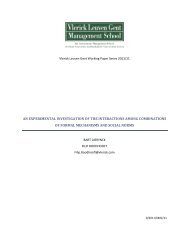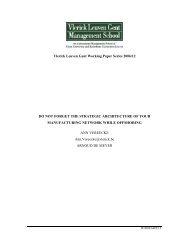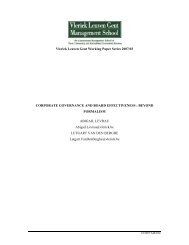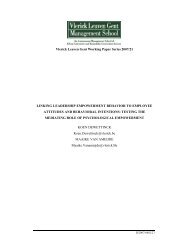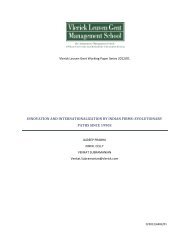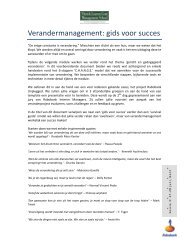development of the loss aversion questionnaire shari ... - Vlerick Public
development of the loss aversion questionnaire shari ... - Vlerick Public
development of the loss aversion questionnaire shari ... - Vlerick Public
You also want an ePaper? Increase the reach of your titles
YUMPU automatically turns print PDFs into web optimized ePapers that Google loves.
DEVELOPMENT OFTHE LOSS AVERSIONQUESTIONNAIRESHARI DE BAETSMARC BUELENSOctober 2012September 20122012/092012/09D/2012/6482/09
ABSTRACTLittle is known about individual differences in <strong>loss</strong> <strong>aversion</strong>. This is particularly surprising if oneconsiders <strong>the</strong> strong emphasis on individual differences in both economics and psychology. A LossAversion Questionnaire is proposed as an instrument that is capable <strong>of</strong> measuring interindividualdifferences in <strong>loss</strong> <strong>aversion</strong>. Two studies (N1 = 187; N2 = 455) were conducted to validate <strong>the</strong>measure. Results support <strong>the</strong> view that <strong>loss</strong> <strong>aversion</strong> can be conceptualized as a measure <strong>of</strong>interindividual difference. Various groups (students, entrepreneurs, managers, and civil servants)were found to differ significantly in <strong>the</strong> degree to which <strong>the</strong>y displayed <strong>loss</strong> <strong>aversion</strong>. Fur<strong>the</strong>rmore,we report on issues <strong>of</strong> differential validity with o<strong>the</strong>r well-known concepts such as risk <strong>aversion</strong>,impulsivity, and anxiety3
From <strong>the</strong> abovementioned research, we may infer that individual differences in <strong>loss</strong> <strong>aversion</strong>do exist. We propose that <strong>the</strong>y can be measured with a psychometric <strong>questionnaire</strong> to overcome <strong>the</strong>issues associated with ma<strong>the</strong>matical choice dilemmas.Hypo<strong>the</strong>sis 1. Individual differences in <strong>loss</strong> <strong>aversion</strong> can be measured with a psychometric<strong>questionnaire</strong>.For <strong>the</strong> relation between <strong>loss</strong> <strong>aversion</strong> and personality traits, we can refer to <strong>the</strong> researchinto <strong>the</strong> relation between risk <strong>aversion</strong> and personality traits. In a study <strong>of</strong> reported risk taking overseveral decision domains, risk taking overall was associated positively with extr<strong>aversion</strong> andopenness, and negatively with neuroticism, agreeableness, and conscientiousness (Nicholson, Soane,Fenton-O’Creevy, & Willman, 2005). Ano<strong>the</strong>r study found that risk taking was positively associatedwith openness and negatively with agreeableness and conscientiousness (Kowert & Hermann, 1997).According to Soane and Chmiel (2005), <strong>the</strong> research into <strong>the</strong> relationship between risk andpersonality has two important ramifications. First, people will avoid (or take) risks consistent with<strong>the</strong>ir character. Second, because personality is relatively stable throughout adulthood (McCrae &Costa, 1997), <strong>the</strong> tendency to avoid (or take) risks may also be robust. In line with <strong>the</strong>ir research, wepropose that <strong>loss</strong> <strong>aversion</strong> is also correlated with stable personality traits.As stated above, <strong>loss</strong> <strong>aversion</strong> is thought to be responsible for <strong>the</strong> majority <strong>of</strong> risk <strong>aversion</strong>(Kobberling & Wakker, 2005); thus, <strong>the</strong> following hypo<strong>the</strong>sis can be deduced.Hypo<strong>the</strong>sis 2. Loss <strong>aversion</strong> is positively related to risk <strong>aversion</strong>.It has been suggested by Camerer (2005) that <strong>the</strong> basis <strong>of</strong> <strong>loss</strong> <strong>aversion</strong> lies in fear. This issupported by <strong>the</strong> finding by De Martino et al. (2010) that patients with lesions to <strong>the</strong> amygdala, <strong>the</strong>brain region associated with fear processing, experienced no <strong>loss</strong> <strong>aversion</strong>. In addition, Loewenstein(2001) proposed that, in line with this risk-as-feelings hypo<strong>the</strong>sis, risk-related research should takeemotions into account. Considering <strong>the</strong> neurological basis and support from <strong>the</strong> risk-as-feelingshypo<strong>the</strong>sis, we will investigate <strong>the</strong> relationship between <strong>loss</strong> <strong>aversion</strong> and fear.Hypo<strong>the</strong>sis 3. Loss <strong>aversion</strong> is positively related to anxiety.It has been suggested that <strong>the</strong> neural systems responsible for <strong>loss</strong> <strong>aversion</strong> are <strong>the</strong> same asthose for impulsive behavior (e.g. Tom, Fox, Trepel, & Poldrack, 2007). Damage to <strong>the</strong> DA system, for7
A positive relationship was predicted between <strong>the</strong> Loss Aversion Questionnaire and <strong>the</strong> STAI,measuring anxiety, which was confirmed and significant (r = .298, p < .01).Study 3In study 3, <strong>the</strong> <strong>questionnaire</strong> was tested with a large number <strong>of</strong> participants in variouspositions. The 18 items with <strong>the</strong> highest item total correlation and greatest contribution to <strong>the</strong>overall reliability <strong>of</strong> <strong>the</strong> scale from <strong>the</strong> preliminary studies were retained for larger-scale testing.Sample and ProcedureA survey was conducted among 479 participants. Six hundred paper-and-pencil surveys weredistributed after a lecture on general management for managers (Belgium), a lecture forentrepreneurs (Belgium), a class <strong>of</strong> first-grade economics students (Belgium), and a congress for civilservants (<strong>the</strong> Ne<strong>the</strong>rlands). The response rate was 79%. The <strong>questionnaire</strong> consisted <strong>of</strong> English items;all participants were multilingual, because <strong>the</strong> congress and lectures were in <strong>the</strong> English language. Tominimize bias because <strong>of</strong> social desirability, confidentiality and anonymity were guaranteed. Thesample consisted <strong>of</strong> 296 men (61.80%) and 180 women (37.60%), with a mean age <strong>of</strong> 35.34 (SD =14.22), ranging from 19 to 68 yr. Of <strong>the</strong> respondents, 0.40% held a primary school degree, 45.50% asecondary education degree, 41.50% a university degree (41.50%), and 4.00% a postgraduate degree.The sample consisted <strong>of</strong> 45 managers (9.40%), 55 entrepreneurs (11.50%), 204 students (42.60%),and 173 civil servants (36.10%).MeasuresAll items were answered on a five-point Likert scale (1 = strongly disagree, 5 = strongly agree)to indicate <strong>the</strong> extent to which <strong>the</strong> respondent agreed with <strong>the</strong> statement. To select <strong>the</strong> items from<strong>the</strong> scales, relevance to <strong>the</strong> current study as well as high factor loadings in previous validation studieswere taken into account. Where necessary, small adjustments were made to <strong>the</strong> items so that <strong>the</strong>ywould fit <strong>the</strong> response scale.12
ImpulsivenessImpulsiveness was measured by a selection <strong>of</strong> four items <strong>of</strong> <strong>the</strong> Barratt Impulsiveness Scale(BIS; Barratt, 1959). More specifically, items were selected from a pool <strong>of</strong> 30 items from <strong>the</strong> BIS-11, aself-report scale designed to measure general impulsiveness (Patton, Stanford, & Barratt, 1995).Items were: “I act on impulse,” “I say things without thinking,” “I act on <strong>the</strong> spur <strong>of</strong> <strong>the</strong> moment,”and “I do things without thinking.” Cronbach’s was .80.AnxietyAnxiety was measured using <strong>the</strong> same items as in study 2, from <strong>the</strong> State-Trait AnxietyInventory (STAI; Spielberger, 1983). Cronbach’s was .68.Risk AversionTo measure risk <strong>aversion</strong>, items were used from <strong>the</strong> DOSPERT scale (Weber, Blais, & Betz,2002). The DOSPERT scale was developed by Weber et al. (2002) to measure individual differences inattitude towards risk and is <strong>the</strong> only psychometric scale available for measuring risk <strong>aversion</strong>. From<strong>the</strong> original 40-item scale, 10 items were selected and adapted so that <strong>the</strong>y could be answered onour Likert scale. An example item is “I would dare to invest 10% <strong>of</strong> my annual income in a veryspeculative stock.” Cronbach’s was .56.Loss AversionEighteen items with <strong>the</strong> highest item-total correlation and highest contribution to <strong>the</strong> overallreliability from <strong>the</strong> scale from <strong>the</strong> preliminary studies were retained for larger-scale testing.Cronbach’s was .82.ResultsTable 3 shows <strong>the</strong> means and standard deviations <strong>of</strong> <strong>the</strong> 18 items <strong>of</strong> <strong>the</strong> Loss AversionQuestionnaire. The number <strong>of</strong> missing values was low, ranging from 0% to 0.40% and <strong>the</strong> distribution<strong>of</strong> <strong>the</strong> missing values was considered random (Cohen & Cohen, 1983). The means <strong>of</strong> all items rangedfrom 2.48 to 3.94. All standard deviations exceeded 0.50, indicating adequate variability (Stumpf etal., 1983). Cronbach’s supports hypo<strong>the</strong>sis 1, which states that individual differences in <strong>loss</strong><strong>aversion</strong> can be measured with a psychometric <strong>questionnaire</strong>.13
Insert Table 3 about hereBased on an exploratory principal axis analysis with Oblimin rotation, <strong>the</strong> DOSPERT scale wasremoved because <strong>of</strong> low reliability and low factor loadings. Moreover, items 4 and 17 <strong>of</strong> <strong>the</strong> LossAversion Questionnaire were deleted because <strong>of</strong> a strong wording effect. BIS (impulsivity) loaded ona single factor and had no confounding characteristics with <strong>the</strong> items <strong>of</strong> <strong>the</strong> Loss AversionQuestionnaire. We <strong>the</strong>n repeated <strong>the</strong> exploratory principal axis analysis with Oblimin rotation with<strong>the</strong> <strong>loss</strong> <strong>aversion</strong> and anxiety scales on two factors (Table 3). We chose Oblimin rotation given <strong>the</strong>correlation between <strong>the</strong> two scales. Only <strong>the</strong> items with a factor loading above .40 on <strong>the</strong> secondfactor (<strong>loss</strong> <strong>aversion</strong>), with no significant loadings ( .9,and a root mean square error <strong>of</strong> approximation (RMSEA) < .06 (Hu & Bentler, 1999). The resultsindicated a good fit (² (100) = 221, 398, p < .001; RLR: 2.21; RMSEA = .05; and CFI = .921).Insert Table 4 about here14
Sociodemographic VariablesGender.—Men and women did not differ significantly in <strong>the</strong>ir score on <strong>loss</strong> <strong>aversion</strong> (F =4.361, p = .102) or impulsivity (F = .158, p = .125). They did, however, differ significantly in <strong>the</strong>ir scoreon anxiety (F = .374, p = .003) with women scoring higher on anxiety (mean = 2.82) than men (mean= 2.62).Educational level.—Participants differed significantly according to <strong>the</strong>ir educational level in<strong>the</strong>ir score on <strong>loss</strong> <strong>aversion</strong> (F = 80.457, p < .001) and anxiety (F = 17.836, p < .001), and <strong>the</strong>difference was marginally significant in <strong>the</strong>ir score on impulsivity (F = 2.211, p < .10). Having auniversity or postgraduate degree (N = 198, mean = 2.82) significantly reduced displayed <strong>loss</strong><strong>aversion</strong> (F = .018, p < .000) compared with secondary education (N = 207, mean = 3.44). The number<strong>of</strong> people with only primary school education (N = 2) was insufficient to draw valid conclusions.Similarly, people holding a university or postgraduate degree (N = 198, mean = 2.48) had significantlylower scores on anxiety (F = .852, p < .000) compared with those with only secondary education (N =216, mean = 2.96). A university or postgraduate degree (N = 198, mean =2.58) also meant adecreased impulsivity score (F = 9.519, p < .05) compared with secondary education alone (N = 207,mean = 2.76).Employment type.—Participants also differed significantly according to <strong>the</strong>ir employmenttype in <strong>the</strong>ir scores on <strong>loss</strong> <strong>aversion</strong> (F = 80.399, p < .001), anxiety (F = 19.891, p < .001), andimpulsivity (F = 5.678, p < .001). Students displayed <strong>the</strong> highest average score on <strong>loss</strong> <strong>aversion</strong> (mean= 3.46) and anxiety (mean = 2.97), and entrepreneurs displayed <strong>the</strong> highest average score onimpulsivity (mean = 2.79). The lowest average score on impulsivity (mean = 2.30) was displayed bymanagers, as well as <strong>the</strong> lowest average score on anxiety (mean = 2.43). The lowest average score on<strong>loss</strong> <strong>aversion</strong> (mean = 2.78) was for <strong>the</strong> civil servants group.Age.—Participants scored differently according to <strong>the</strong>ir age on <strong>loss</strong> <strong>aversion</strong> (F = 5.574, p
Related VariablesHypo<strong>the</strong>sis 2 predicted a positive relationship between <strong>loss</strong> <strong>aversion</strong>, measured by <strong>the</strong> LossAversion Questionnaire, and risk <strong>aversion</strong>, measured by <strong>the</strong> DOSPERT scale. However, because <strong>of</strong> <strong>the</strong>low reliability <strong>of</strong> <strong>the</strong> DOSPERT scale in this study, <strong>the</strong> hypo<strong>the</strong>sis cannot be tested. Similarly,hypo<strong>the</strong>sis 3 predicted a positive relationship between <strong>the</strong> Loss Aversion Questionnaire and <strong>the</strong>State-Trait Anxiety Inventory, measuring anxiety, which was confirmed and significant (r = .290, p
DISCUSSIONThe present study aimed to contribute to <strong>the</strong> <strong>loss</strong> <strong>aversion</strong> literature by focusing onindividual differences, which is a consistent gap in behavioral research (Li & Liu, 2008; Mohammed &Schwall, 2009; Stanovich & West, 1998).It was argued that <strong>loss</strong> <strong>aversion</strong> is subject to individual differences and can be seen as apersonality trait. The question remained concerning how to measure effectively those differences.We argued that <strong>the</strong> current measurement methods have limitations and that <strong>loss</strong> <strong>aversion</strong> can bemeasured more effectively by using a psychometric <strong>questionnaire</strong>. Loss <strong>aversion</strong> as a personality traitis supported by a wide array <strong>of</strong> research results, ranging from laboratory experiments (e.g. Gächteret al., 2007) to neuroscientific research (e.g. Tom et al., 2007). So far, measurements <strong>of</strong> <strong>loss</strong> <strong>aversion</strong>are usually conducted in laboratories in <strong>the</strong> format <strong>of</strong> ma<strong>the</strong>matical choice dilemmas. It was arguedthat <strong>the</strong> predictive validity <strong>of</strong> expected utility-based assessments <strong>of</strong> <strong>loss</strong> <strong>aversion</strong> is questionable,because such assessments typically limit choice and restrict behavior, <strong>the</strong>reby giving personalitytraits little time to manifest (Mohammed & Schwall, 2009). Issues with external validity, limitedindividual variety, and applicability for innumerate people were discussed. To measure <strong>loss</strong> <strong>aversion</strong>in a more valid way, a psychometric <strong>questionnaire</strong> was proposed—namely, <strong>the</strong> Loss AversionQuestionnaire (LAQ).The internal consistency <strong>of</strong> <strong>the</strong> scales was acceptable, with Cronbach’s ranging from .68 to.82. An exception to <strong>the</strong> case was <strong>the</strong> DOSPERT scale with a Cronbach’s <strong>of</strong> .56. The full version <strong>of</strong><strong>the</strong> DOSPERT scale has been validated and normally shows acceptable internal consistency andconstruct reliability, ranging from .70 to .84 (Weber et al., 2002). Although <strong>the</strong> reason for our lowCronbach’s remains unclear, a low reliability for <strong>the</strong> DOSPERT scale has been found before (Brown,2011).We predicted and found a significant positive relationship between <strong>loss</strong> <strong>aversion</strong> and risk<strong>aversion</strong>, and between <strong>loss</strong> <strong>aversion</strong> and anxiety. Although we predicted a negative relationshipbetween impulsivity and <strong>loss</strong> <strong>aversion</strong>, <strong>the</strong> results show a significant positive relationship. The reasonfor this remains unclear.The finding that people differ significantly in <strong>the</strong>ir degree <strong>of</strong> displayed <strong>loss</strong> <strong>aversion</strong> accordingto educational level, employment level, and age was unexpected. Higher education seems to reduce<strong>the</strong> amount <strong>of</strong> displayed <strong>loss</strong> <strong>aversion</strong>, which was also noticed by Gächter et al. (2007). They refer to<strong>the</strong> findings from neuroscience (Tom et al., 2007), primate research (Chen, Lakshminarayanan, &Santos, 2006), and young children (Harbaugh, Krause, & Vesterlund, 2001), which suggest that <strong>loss</strong><strong>aversion</strong> is deeply rooted, and requires learning and experience to overcome. Following <strong>the</strong> same17
easoning, age should also reduce displayed <strong>loss</strong> <strong>aversion</strong>. This was confirmed by our study, withpeople below <strong>the</strong> median age scoring significantly higher on <strong>loss</strong> <strong>aversion</strong> than people above.Limitations and Future ResearchBecause <strong>of</strong> <strong>the</strong> ra<strong>the</strong>r low reliability score on <strong>the</strong> DOSPERT scale, <strong>the</strong> hypo<strong>the</strong>sis concerningrisk <strong>aversion</strong> could not be tested. The correlation between impulsivity and <strong>loss</strong> <strong>aversion</strong> was notsignificant; <strong>the</strong> reason remains unclear.Our study aimed at a large target audience, instead <strong>of</strong> focusing on well-educated youngpeople, as is <strong>the</strong> case with laboratory experiments. Although we reached a broad audience withregard to age (range 19–68 yr.), <strong>the</strong> educational level <strong>of</strong> respondents remained quite high with 45.5%holding a high school qualification and 49.3% a university or postgraduate degree. Fur<strong>the</strong>r researchshould seek to include people with lower educational attainment.Likewise, future research should test <strong>the</strong> Loss Aversion Questionnaire with a longitudinaldesign, which would test for <strong>the</strong> stability <strong>of</strong> <strong>loss</strong> <strong>aversion</strong> as a personality trait.This paper has contributed to <strong>the</strong> <strong>loss</strong> <strong>aversion</strong> literature by shedding light on <strong>the</strong>psychological side <strong>of</strong> <strong>the</strong> phenomenon and highlighting <strong>the</strong> importance <strong>of</strong> individual differences in<strong>loss</strong> <strong>aversion</strong>. The LAQ promises to be a useful and valid <strong>questionnaire</strong> for measuring <strong>loss</strong> <strong>aversion</strong> ona large scale without <strong>the</strong> need to resort to ma<strong>the</strong>matical choice dilemmas or o<strong>the</strong>r forced-choicelaboratory tasks.18
Eibach, R., & Keegan, T. (2006). Free at last? Social dominance, <strong>loss</strong> <strong>aversion</strong>, and white and blackAmericans’ differing assessments <strong>of</strong> racial progress. Journal <strong>of</strong> Personality and Social Psychology,90(3), 453 - 467.Gächter, S., Johnson, E. J., & Herrmann, A. (2007). Individual-level <strong>loss</strong> <strong>aversion</strong> in riskless and riskychoices. CeDEx Discussion Paper. University <strong>of</strong> Nottingham.Haigh, M. S., & List, J. A. (2005). Do pr<strong>of</strong>essional traders exhibit myopic <strong>loss</strong> <strong>aversion</strong>? Anexperimental analysis. The Journal <strong>of</strong> Finance, 60(1), 523 - 534.Harbaugh, W. T., Krause, K., & Vesterlund, L. (2001). Are adults better behaved than children? Age,experience, and <strong>the</strong> endowment effect. Economic Letters, 70(2), 175 - 181.Haynes, S. N., Richard, D. C. S., & Kubany, E. S. (1995). Content validity in psychological assessment: afunctional approach to concepts and methods. Psychological Assessment, 7(238 - 247).Heath, C., Larrick, R. P., & Wu, W. (1999). Goals as reference points. Cognitive psychology, 38, 79 -109.Hochman, G., & Yechiam, E. (in press). Loss <strong>aversion</strong> in <strong>the</strong> eye and in <strong>the</strong> heart: The autonomicnervous system’s response to <strong>loss</strong>es. Journal <strong>of</strong> Behavioral Decision Making.Holmes, R. M., Bromiley, P., Devers, C. E., Holcomb, T. R., & McGuire, J. B. (2011). Management<strong>the</strong>ory applications <strong>of</strong> prospect <strong>the</strong>ory: Accomplishments, challenges, and opportunities. Journal <strong>of</strong>Management, 37(4), 1069 - 1107.Hommes, C. (2006). Heterogeneous agent models in economics and finance. In K. L. J. In L. Tesfatsion(Ed.), Handbook <strong>of</strong> computational economics, agent-based computational economics (pp. 1109 –1186): Amsterdam: Elsevier.Hu, L., & Bentler, P. M. (1999). Cut<strong>of</strong>f criteria in fix indexes in covariance structure analysis:conventional criteria versus new alternatives. Structural Equation Modeling, 6, 1 - 55.Kahneman, D., Knetsch, J. L., & Thaler, R. H. (1990). Experimental tests <strong>of</strong> <strong>the</strong> endowment effect and<strong>the</strong> Coase Theorem. The Journal <strong>of</strong> Political Economy, 98(6), 1325 - 1348.Kahneman, D., & Tversky, A. (1979). Prospect Theory: an analysis <strong>of</strong> decision under risk.Econometrica, 47(2), 263 - 291.20
TABLE 1Means and Standard Deviations <strong>of</strong> Initial Pool <strong>of</strong> Items <strong>of</strong> study 1 (N = 65)Item Mean SD1. If I lose a sweater at home, I keep on searching until I find it. 3.40 1.442. I really don’t care if someone talks bad about me behind my back. (R) 3.55 1.153. I would feel very down if I got fired, even if I know I will find a similar job. 3.48 1.234. I would hate it if a colleague thought that I’m not as good in my job now as Iwas before.3.74 0.965. In marriage, a woman should keep her own last name. 3.75 1.116. In a relationship, I would hate not having my separate group <strong>of</strong> friends. 3.45 1.077. Losing your house to a fire is bad, but I would manage. (R) 2.30 1.158. I think eventually I could cope with losing <strong>the</strong> ability to walk. (R) 3.68 1.239. I tend to keep old stuff around. 2.89 1.1910. If my reputation in <strong>the</strong> company takes a blow, I wouldn’t want to come towork anymore.2.75 1.2111. If I can’t find <strong>the</strong> documents I’m looking for, I get real nervous. 3.58 1.0512. Once I’ve acquired a position in <strong>the</strong> company, I wouldn’t want to take astep back.3.69 1.0713. I would feel very emotional if my car (bike) would be stolen. 2.97 1.4014. I don’t care if my boss thinks less <strong>of</strong> me than I’m really worth. (R) 3.74 1.1815. I don’t like throwing away stuff. 3.11 1.1916. I wouldn’t care if I had to move to a smaller place. (R) 3.00 1.2517. I’d ra<strong>the</strong>r quit than get fired. 4.02 1.0918. I would never accept a job that has less pay than my previous/current one. 2.36 1.0219. I wouldn’t like it if <strong>the</strong> company changed our way <strong>of</strong> working. 2.46 1.0320. I don’t care what people would think if I was suddenly unemployed. (R) 3.11 1.3223
TABLE 2Means and Standard Deviations <strong>of</strong> Initial Pool <strong>of</strong> Items <strong>of</strong> study 2 (N = 122)Item Mean SD1. If I lose a sweater at home, I keep on searching until I find it. 3.43 1.132. I really don’t care if someone talks bad about me behind my back. (R) 3.82 0.983. I would feel very down if I got fired, even if I know I will find a similar job. 3.61 1.104. I would hate it if a colleague thought that I’m not as good in my job now as Iwas before.3.71 0.905. In marriage, a woman should keep her own last name. 3.77 1.036. In a relationship, I would hate not having my separate group <strong>of</strong> friends. 3.06 0.997. Losing your house to a fire is bad, but I would manage. (R) 2.43 0.888. I think eventually I could cope with losing <strong>the</strong> ability to walk. (R) 3.33 1.169. I tend to keep old stuff around. 3.36 1.1510. If my reputation in <strong>the</strong> company takes a blow, I wouldn’t want to come towork anymore.2.48 0.8311. If I can’t find <strong>the</strong> documents I’m looking for, I get real nervous. 3.37 0.9012. Once I’ve acquired a position in <strong>the</strong> company, I wouldn’t want to take a stepback.3.47 1.0713. I would feel very emotional if my car (bike) would be stolen. 3.18 1.1414. It’s horrible if your boss thinks less <strong>of</strong> you than you’re really worth. 3.87 0.8815. I don’t like throwing away stuff. 3.30 1.1616. I would have problems with having to move to a smaller place. 2.98 1.0417. I’d ra<strong>the</strong>r quit than get fired. 3.58 1.1418. I would have no problem accepting a job that has less pay than myprevious/current one. (R)3.09 1.0319. I would feel very tense if <strong>the</strong> company changed our way <strong>of</strong> working. 2.50 0.9120. I don’t care what people would think if I was suddenly unemployed. (R 3.18 1.0521. I always save my computer files on different locations. 3.40 1.3222. I think I could cope losing all my belongings in a fire. (R) 3.17 1.0823. I think I would go crazy, being locked up in prison. 3.67 1.1624. I would be okay with trading my current car (bike) for a cheaper model. (R) 2.99 1.1225. I get easily attached to material things (my car, my furniture, ..). 3.07 1.0724
TABLE 3Means and Standard Deviations <strong>of</strong> Items <strong>of</strong> study 3 (N = 479)Item Mean SD1. It’s horrible if your boss thinks less <strong>of</strong> you than you’re really worth. 3.94 0.862. I get easily attached to material things (my car, my furniture, ..). 2.97 1.103. I would have problems with having to move to a smaller place. 2.98 1.124. I tend to keep old stuff around. 2.88 1.075. I think eventually I could cope with losing <strong>the</strong> ability to walk. (R) 3.32 1.186. I go crazy if I lose something, even when it’s not that important. 2.65 1.117. Once I’ve acquired a position in <strong>the</strong> company, I wouldn’t want to take a stepback.3.52 1.048. I think I could cope losing all my belongings in a fire. (R) 3.23 1.159. I would feel very down if I got fired, even if I know I will find a similar job. 3.33 1.0410. I don’t care what people would think if I was suddenly unemployed. (R) 3.13 1.0711. I don’t like throwing away stuff. 2.95 1.1112. I would feel very emotional if my car (bike) would be stolen. 3.11 1.1513. I feel awful if someone talks bad about me behind my back. 3.60 1.0114. I would hate it if a colleague thought that I’m not as good in my job now as Iwas before.3.49 0.9115. Losing your house to a fire is bad, but I would manage. (R) 2.49 0.9816. I would feel very tense if <strong>the</strong> company changed our way <strong>of</strong> working. 2.50 0.8817. I would have no problem accepting a job that has less pay than myprevious/current one. (R)3.26 1.0218. I would be okay with trading my current car (bike) for a cheaper model. (R) 2.74 1.0325
TABLE 4a – 4b – 4c – 4dPrincipal axis analysis with Direct Oblimin rotation (STAI & LAQ)4a. CommunalitiesInitialExtractionI worry too much over something that really doesn’t matter. .388 .450I get in a state <strong>of</strong> tension or turmoil as I think over my recent concerns and interests. .195 .168I have disturbing thoughts. .304 .301I take disappointments so keenly that I can’t put <strong>the</strong>m out <strong>of</strong> my mind. .355 .417It’s horrible if your boss thinks less <strong>of</strong> you than you’re really worth. .270 .178I get easily attached to material things (my car, my furniture, ..) .251 .249I would have problems with having to move to a smaller place. .166 .138I think eventually I could cope with losing <strong>the</strong> ability to walk. .291 .239I feel awful if someone talks bad about me behind my back. .253 .200I go crazy if I lose something, even when it’s not that important. .331 .322I think I could cope losing all my belongings in a fire. .428 .270Once I’ve acquired a position in <strong>the</strong> company, I wouldn’t want to take a step back. .265 .206Losing your house to a fire is bad, but I would manage. .454 .333I would hate it if a colleague thought that I’m not as good in my job now as I was before. .338 .221I would feel very down if I got fired, even if I know I will find a similar job. .286 .251I don’t care what people would think if I was suddenly unemployed. .303 .293I would feel very tense if <strong>the</strong> company changed our way <strong>of</strong> working. .242 .238I would have no problem accepting a job that has less pay than my previous/current one. .294 .299I would be okay with trading my current car (bike) for a cheaper model. .341 .395I would feel very emotional if my car (bike) would be stolen. .251 .21426
4b Pattern MatrixFactor1 2I worry too much over something that really doesn’t matter. .699 -.061I get in a state <strong>of</strong> tension or turmoil as I think over my recent concerns and interests. .447 -.096I have disturbing thoughts. .594 -.115I take disappointments so keenly that I can’t put <strong>the</strong>m out <strong>of</strong> my mind. .637 .017It’s horrible if your boss thinks less <strong>of</strong> you than you’re really worth. .230 .261I get easily attached to material things (my car, my furniture, ..) .066 .465I would have problems with having to move to a smaller place. -.009 .375I think eventually I could cope with losing <strong>the</strong> ability to walk. .029 .474I feel awful if someone talks bad about me behind my back. .419 .052I go crazy if I lose something, even when it’s not that important. .470 .164I think I could cope losing all my belongings in a fire. .055 .491Once I’ve acquired a position in <strong>the</strong> company, I wouldn’t want to take a step back. .027 .440Losing your house to a fire is bad, but I would manage. .159 .483I would hate it if a colleague thought that I’m not as good in my job now as I was before. .389 .136I would feel very down if I got fired, even if I know I will find a similar job. .406 .157I don’t care what people would think if I was suddenly unemployed. .333 .296I would feel very tense if <strong>the</strong> company changed our way <strong>of</strong> working. .351 .209I would have no problem accepting a job that has less pay than my previous/current one. -.096 .587I would be okay with trading my current car (bike) for a cheaper model. -.120 .678I would feel very emotional if my car (bike) would be stolen. .254 .284EigenvaluePercentage <strong>of</strong> total variance accounted for5.00525.025%1.7838.916%27
4c. Structure MatrixFactor1 2I worry too much over something that really doesn’t matter. .669 .275I get in a state <strong>of</strong> tension or turmoil as I think over my recent concerns and interests. .401 .119I have disturbing thoughts. .539 .171I take disappointments so keenly that I can’t put <strong>the</strong>m out <strong>of</strong> my mind. .646 .324It’s horrible if your boss thinks less <strong>of</strong> you than you’re really worth. .355 .371I get easily attached to material things (my car, my furniture, ..) .289 .496I would have problems with having to move to a smaller place. .171 .371I think eventually I could cope with losing <strong>the</strong> ability to walk. .257 .488I feel awful if someone talks bad about me behind my back. .445 .254I go crazy if I lose something, even when it’s not that important. .549 .390I think I could cope losing all my belongings in a fire. .292 .518Once I’ve acquired a position in <strong>the</strong> company, I wouldn’t want to take a step back. .239 .453Losing your house to a fire is bad, but I would manage. .392 .560I would hate it if a colleague thought that I’m not as good in my job now as I was before. .454 .323I would feel very down if I got fired, even if I know I will find a similar job. .481 .352I don’t care what people would think if I was suddenly unemployed. .476 .456I would feel very tense if <strong>the</strong> company changed our way <strong>of</strong> working. .452 .378I would have no problem accepting a job that has less pay than my previous/current one. .187 .541I would be okay with trading my current car (bike) for a cheaper model. .206 .620I would feel very emotional if my car (bike) would be stolen. .390 .4064d. Factor Correlation MatrixFactor 1 21 1.000 .4812 .481 1.000Extraction Method: Principal Axis Factoring.Rotation Method: Oblimin with Kaiser Normalization.28



